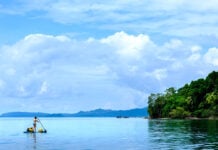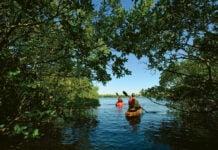Watch Out
Except for Lake Alexandrina, the Murray’s waters are generally safe and calm, and can be traveled end-to-end on the main channel without portaging, though you’ll have to master the locks. In summer, the likelihood of snake encounters increases, but there are no crocodiles this far south.
Don’t Miss
The iconic Massive Murray Paddle marathon (massivemurraypaddle.org.au) stretches 250 miles. Raise money for charity and test your stamina against the hundreds of participants who flock to the five-day event each November.
Diversions
Understanding how the Murray is connected to the land requires getting off the water. The award-winning Murray River Walk (murrayriverwalk.com.au) offers a three-day, 25-mile interpretative tour of the floodplains, bush and cliffs surrounding the Murray and its backwaters.
Outfitters
In addition to a prime put-in spot, Canoe the Riverland (canoetheriverland.com) offers onsite camping, guided tours and maps of the region. For a plush and on-theme stay before or during your paddle, bunk down in their refurbished paddleboat B&B.
Must-Have
Cell phone service throughout inland Australia is spotty. A satellite communications device and snakebite kit are a must. In addition to Renmark-area maps produced by Canoe the Riverland, pick up River Murray Charts for South Australia, New South Wales and Victoria (rivermurraycharts.com.au).
There are few places where you can see history written on the walls—or, as is the case along Australia’s Murray River, carved into the trees.
Paddling through the Murray’s milky-green waters, it’s easy to spot one of the ancient “canoe trees”—so named for the yards-long scars marking their surfaces. For hundreds of years, this is where Aboriginal people painstakingly carved their watercraft from a single piece of river red gum bark.
But despite the area’s long paddling history, the waterway hasn’t always existed. Well, not technically. When explorer Charles Sturt charted it in 1830—describing it as a “broad and noble river” on which he allowed his boats to “drift along at pleasure”—it was flowing. But had he arrived in another month or year? It could have just been a trickle across a dry floodplain.
Once ephemeral, the Murray only became a permanent fixture of the otherwise sunburnt landscape when a series of locks were constructed in the early 20th century. Today, it’s the third-longest navigable river in the world, stretching for over 1,550 miles from the Snowy Mountains to Lake Alexandrina in the south, near Adelaide.
Like Sturt’s crew learned, the Murray is best enjoyed when you drift along it at pleasure. Leisurely days paddling alongside sandstone cliffs the color of orange creamsicles are punctuated only by passing houseboats and occasional sightings of emus drinking from the river’s sandy banks. Countless winding backwaters allow for close-up interactions with birds, kangaroos and echidnas.
“You can spend days out there. You can daisywheel and come back,” says Ruth Roberts, owner of Canoe the Riverland, who finished paddling the entire river from mouth-to-sea in 2013. “It’s the most remote and unspoiled area.”
If you have a half day:
Renmark, South Australia, is the ideal jump-off spot for day trips, including into the Murray’s serene backwaters. Launch at Plummers Creek and paddle your way into the Horseshoe Lagoon, where you may spot mistletoe birds, yellow rosellas or red kangaroos hiding amongst the trees on the nearby floodplains.
If you have a day:
Eliminate the need for a shuttle with a nine-mile loop of Ral Ral Creek. Starting directly in Renmark, paddle up toward Kylie Creek and loop around the first island before shooting back out onto the main channel towards town. Nearby Bulyong Island is a favorite amongst local paddlers—separated from the mainland, this national park and waterfowl habitat is only accessible via watercraft.
If you have a weekend:
Two days gives you time to explore both the river’s expansive main channel and the winding backwaters of Chowilla Creek (pronounced “chow-la”). Making your way downstream, stop at Headings Cliff Lookout for sublime views. After passing by the shipwreck of SS Kelvin, set up camp at Wooleneck Bend. Once the site of a World War II internment camp, ruins still remain.
If you have a week:
Not for the faint-hearted, the most remote section of the river, between Wentworth and Paringa, is worth the effort. Once a shipping route, this secluded 137-mile stretch of water starts where the Murray and Darling Rivers meet in New South Wales, and ends at South Australia’s Customs House, the historic toll point for paddle steamers.
Passing through three states—New South Wales, Victoria, and South Australia—the Murray boasts a wealth of historical towns, first-rate wine regions and wilderness areas. | Photo: Jessica Wynne Lockhart








